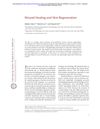Skin Structure and Function, Wound Healing and Scarring
April 2021
in “
Elsevier eBooks
”
TLDR The document concludes that wound healing leads to skin repair or scar formation.
The document describes the skin and its functions, including protection against various agents, hydration control, sensory and thermoregulatory roles, vitamin D synthesis, immune surveillance, and socio-sexual communication. It details the skin's structure, consisting of the epidermis and dermis, and differentiates between glabrous and hairy skin. The process of wound healing is outlined in four phases (coagulation, inflammation, fibroplasia, and remodeling), types (fetal, adult, acute, and chronic), ages (young, plateau, regressing, and atrophic), and systems (epidermal and dermal). The document highlights the significance of early wound closure techniques, such as suturing and skin replacement, in improving healing outcomes. It concludes by noting that wound healing results in either re-epithelialization or the formation of different types of scars, including hypertrophic and keloid scars.




